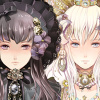Lucky Charms : No 529 / 2020.8
「和」とは古くから日本の伝統的な概念を表す言葉でした。また漢(中国)や洋(西洋)など外国からの事物に対比しても使われてきました。今回は、この国で長きに渡って培われた文化であり、生命力の象徴でもある「縁起物」を描きました。「縁起物」は祭事と深く結びついています。日本の祭事には、インドや中国などの外国文化を、精霊信仰の深い日本風と融合させたものが多く存在します。文化を取り込み、アレンジし、それを伝統として楽しみ重んじる。「縁起物」は様々な「和」の文化の中でも、非常に日本らしい性質のものと考えました。この絵では、お神輿の上に紅白の狸と狐。米俵に桜梅桃李など、30以上の幸福のモチーフを熊手のように詰め込んでいます。
The word “Wa” has long been used to describe traditional Japanese concepts. It has also been used in contrast to those of foreign countries such as China and the West. This time, I drew “lucky charms,” a symbol of life force that has existed in Japan since ancient times. Lucky charms are deeply related to Shinto rituals. Many of Japan’s Shinto rituals are a fusion of foreign cultures, such as India and China, and Japan’s deep belief in spirits. We take that culture, arrange it, enjoy it as a tradition, and respect it. Among the various “Japanese” cultures, I found “lucky charms” to be a very Japanese characteristic. In this painting, a red and white raccoon dog and fox are depicted on top of a portable shrine. In this painting, a rake-like container is filled with more than 30 different motifs of happiness, including cherry blossoms, plums, and peaches.
絵師100人展10(http://www.eshi100.com/)展示会のテーマは「和」。
2020年1月製作

 Shopping Guide
Shopping Guide







0 comment